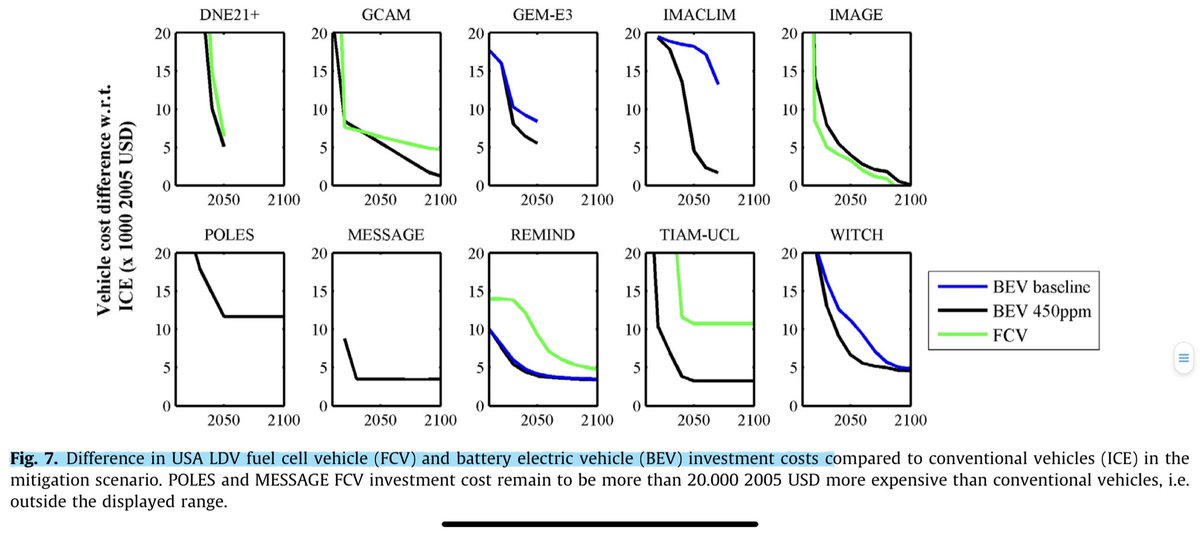
A few thoughts on Tesla's battery day: 🔋🔋🔋
What does it mean for EV cost parity, and how about those V2G comments?
What does it mean for EV cost parity, and how about those V2G comments?

Tesla said it will produce a $25,000 EV in 3 years. This will be achieved with cheaper battery cells, which were projected to cost 56% less in three years. wsj.com/articles/tesla…
For reference, average battery pack costs have declined 20%/year on average since 2010, per BNEF.
For reference, average battery pack costs have declined 20%/year on average since 2010, per BNEF.

Back in 2018 Tesla had the same goal to bring a $25k EV to market in 3 years. This is not to put down their good efforts or anything. It's just meant to show that this is a hard problem and to inform our expectations. wired.com/story/elon-mus…
But let's see what a 56% reduction would mean for EV cost parity with Internal Combustion Engine vehicles.
For this I will use @mitceepr's EV cost parity tool by @KnittelMIT and co-authors, available here: ceepr.mit.edu/publications/w…
For this I will use @mitceepr's EV cost parity tool by @KnittelMIT and co-authors, available here: ceepr.mit.edu/publications/w…

This is using Tesla M3 efficiency of 0.25 kWh/mile (tesla.com/en_EU/support/…), maintenance savings of $240/year (cleantechnica.com/2020/09/26/its…), and the remaining default assumptions. Dashed lines represent today's Brent price and a 2019 battery pack cost of $156/kWh from BNEF. 

A 56% battery pack cost reduction from 2019 would bring us to a price of $68/kWh, plotted below. At this point, EVs become clearly cheaper than ICEs. But even a smaller drop could bring cost parity (according to this simple analysis that would need to be 36% or $100/kWh). 

It's worth noting that this comparison has ignored EV federal and state subsidies here. If we extend and strengthen current policy, EVs look even better. Another caveat is that this assumes average US gasoline taxes. The comparison would differ across sates and countries.
One of the ways Tesla's future batteries will improve is in density, which is projected to improve to 380 Wh/kg.
As you can see in this chart from our MIT Insights into Future Mobility report, this would be at the high end of the current range for commercial chemistries.
As you can see in this chart from our MIT Insights into Future Mobility report, this would be at the high end of the current range for commercial chemistries.

What this chart also shows however is the immense potential that exists with newer chemistries. EV technology has a lot of room for future growth. By the way the report is freely available here: energy.mit.edu/publication/in…
On Battery Day we also heard some interesting comments on Vehicle-to-X (i.e. vehicle to home, or grid, etc.). utilitydive.com/news/tesla-unv…
The biggest news to me was that Tesla now officially plans to make the car electronics V2G capable.
The biggest news to me was that Tesla now officially plans to make the car electronics V2G capable.

This is after a long period of "will they won't they" after CTO Straubel called V2G a non-starter (back in 2016 if I remember correctly), with news like this one which later turned out to be doubtful. electrek.co/2020/05/19/tes…
Now, Tesla doesn't seem super excited about V2G judging by these comments in the Utility Dive article linked above (screen shot here). It'd be interesting to understand better why. Nevertheless, battery day marks a shift in Tesla's V2G stance, dare I say an inflection point. 

My initial thoughts on these comments are that, yes, if you have the money why not have a dedicated stationary battery and an EV. But for many consumers, and for the grid as a whole, there seems to be a huge efficiency potential in using V2G instead of stationary batteries.
V2G doesn't necessarily have to degrade batteries either. We could use smart algorithms to eliminate degradation or even extend battery lifetime (see research here: sciencedirect.com/science/articl…). I am hoping to find the time to write more on all this soon. ~fin~
• • •
Missing some Tweet in this thread? You can try to
force a refresh



